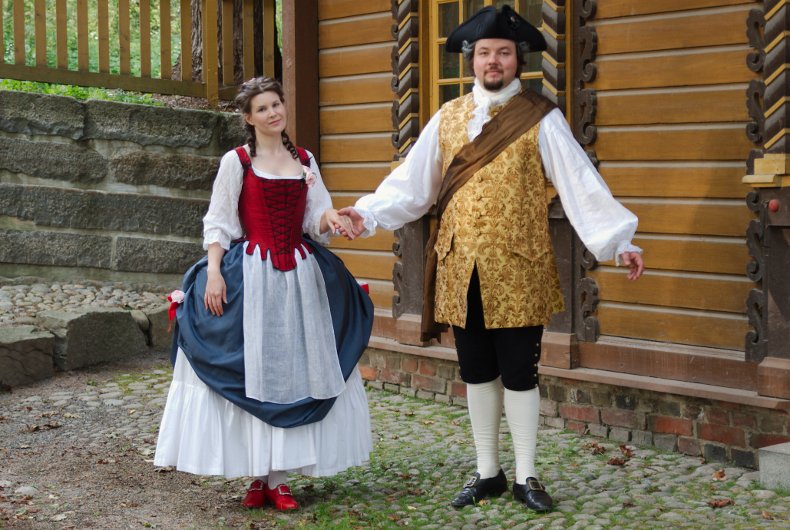
Stays & Shepherdess costume, 2010
For my second masked ball, Le Grand Bal Masque - Ehrensvärd 300v, I wanted a real costume instead of just a mask. A popular 18th century cliche, a shepherdess was both attractive and quite possible to produce with little expense.
The shepherdess outfit must of course have some sort of colourful laced bodice. Some kind of sleeveless jacket might be fine, but I was inspired to make a pair of new, more decorative stays. When we also received an invitation to a wedding with a pirate theme, I could no longer resist the idea of red stays.
It also happened that I had for a long time wanted to do something with a scrap of red and black shot dupioni I had gotten for a really nice price as it was the end of a bolt. Unevenly wowen dupioni is of course not correct for the 18th century, but neither is half of the other stuff I use. I also had some grey material I had used before on corsets.
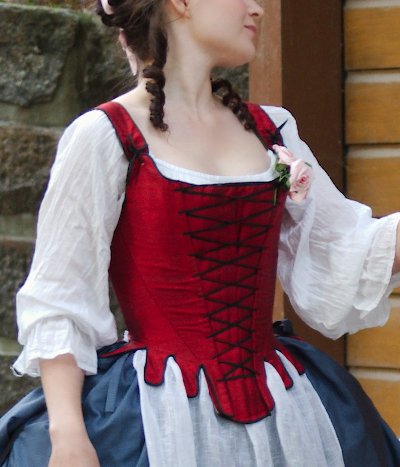
This time I decided to make a more decorative and less stiff stays to be used in masquerade occasions. I based it on the pattern which I used for my first white stays, but made some changes. I added a decorative front lacing over a stomacher piece, which both looks pretty and easily solves the fitting problems on the front which I have with my white stays. I am also ready to admit by now that I was both too optimistic about my endurance for lacing and too pessimistic about the stays stretcthing on use, and in short, my old stays are too tight at the waist which further causes them to not fit quite perfectly. Thus this time I widened the side piece at the waist to make the stays better fitting and also more comfortable. In the process I of course also added an extra tab.
I also decided that for a more relaxed use a less rigid construction and boning would suffice quite well. The boning is reduced to quite scarce, and instead of steel I used flexible and inexpensive plastic cable ties.
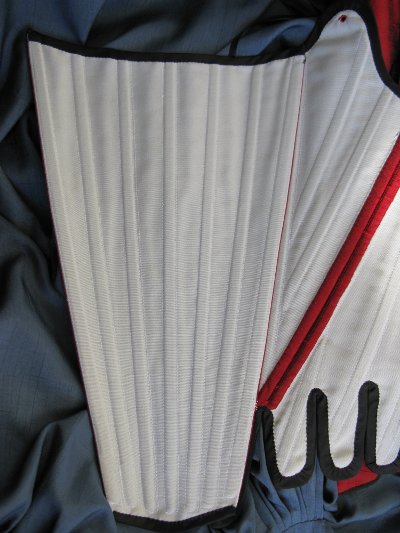
Making new stays gave me a valuable opportunity to ponder about the functionality of my old ones, the fitting of course but also the construction. I ended up treading some new paths, striving for easier and more practical methods. I was greatly inspired by the project gallery of pretty light green stays by Bjarne Drews, who also surely works as period as you can get.
In my white stays the top fabric and the lining fabric are both put together individually before adding them to the boned foundation. It looks neat of course, but gives some trouble with all the separate seam allowances on the lower edge between the tabs. This time I decided to leave the lining out altogether, reasoning that that was what chemise was for.
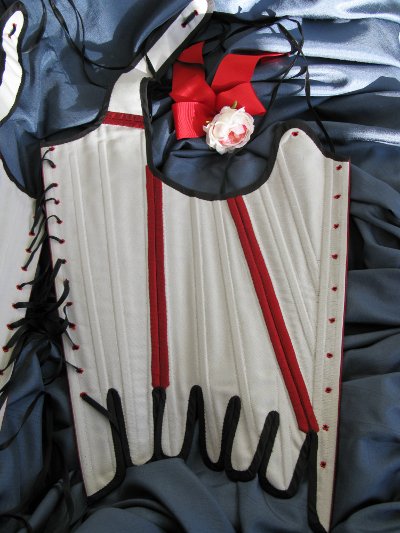
So, I began by drawing the pieces and the boning channels on the doubled foundation material. Then I stitched the boning channels and most of the edges, leaving the top ends of the channels open for inserting the boning of course. I cut the pieces with ample seam allowances, as the pattern edges were visible in the stitched lines anyway. Then I layed them on the silk, stitching the silk on from the edges, again cutting them into individual pieces but with a lot of material around the actual edges. Only the front edges are turned under together.
This time I resorted again to using the modern trick of iron-on interfacing for the dupioni, because it frays so very easily. Now, with the extra material still around the pieces it was easy to carry them with me as I was working on the lacing holes.
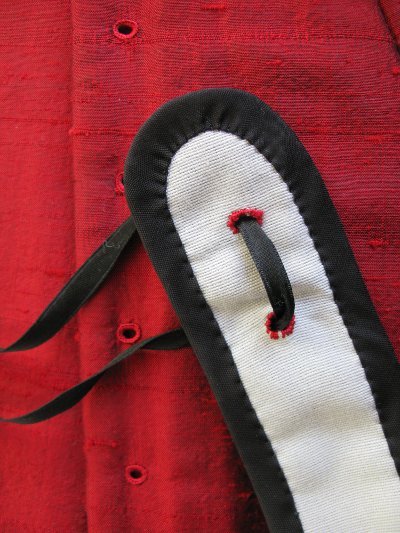
Originally I hadn't wanted to put too much effort on the stays, but as I went of I of course got more ambitious and at this point I was determined to finish all the lacing holes by hand, even though there was twice as much of them now. Once I had made a few, I noticed that they actually went pretty fast. Like on my previous stays, for some reason I still wanted to have a Victorian lacing and not the 18th century one - don't ask me why, it's just a silly obsession.
When the lacing holes were finished I joined the pieces together. I hope that seaming all the layers at once will also protect the silk from being chafed by the thread under strain.
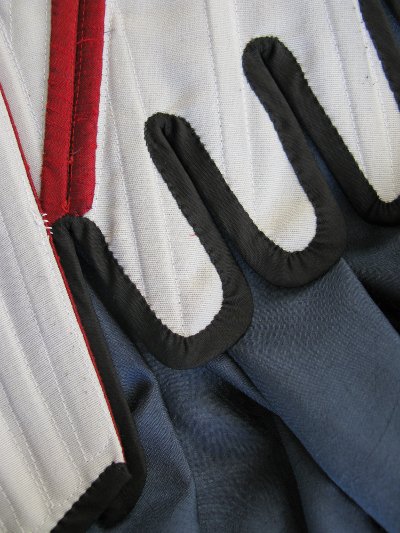
The next thing was binding the lower edge - binding all those tabs is always quite a project. I think I stitched around the tabs one more time to prevent the boning chasing through the fabric. Then I further reinforced the edges with buttonhole stitches. With this I got valuable help from my cousin Fabian who was visiting Finland in the summer. As the stays were in two pieces, he could work on the other side as I worked with the other. He also helped me to sew the binding on the inside as I made the outside. Neat handsewing for beer, what a luxury! (The pictures are showing my side, by the way - it would be dishonest to put someone else's work on my page.)
Fabian's help was valuable indeed, because as often happens, the projects are finished close to the deadline. Unlike in my white stays I had decided to sew the binding on the top edge by hand too, as it was so much faster and easier than the tabs anyway. So, of course I ended up finishing the binding almost at midnight the night before our flight to London. The pirate wedding, the debut of the stays was a great thing, because otherways I would have certainly finished it just before the Ehrensvärd ball, and that week was busy at the work. Not to mention an excuse to go to London for the first time in my life!
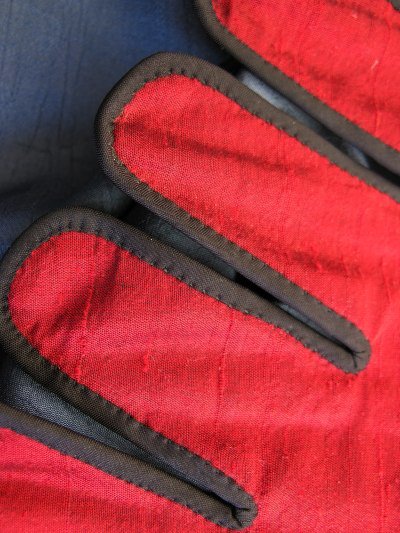
The pirate theme played it's part also on my decision to chose black for the binding and lacing, a color choice which would also suit any gothy outfit I might use the stays for later. Our pirate costumes can be seen here.
Apart from the new stays our pastoral idyll was largely based on existing garments. Jarno wore simply his shirt, waistcoat and breeches, and a new mask found at a medieval faire. He was recognizable as a shepherd by the cane, which was originally a young birch by the nearby road. I peeled it myself, getting a blister in my thumb as I was quite inexperienced. The rest of the dupioni piece went for a bow.
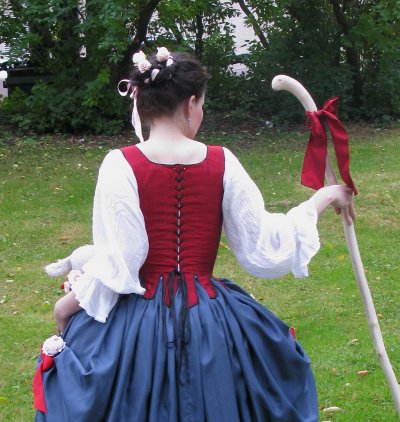
As my chemise had narrow sleeves, I wore this peasant blouse with pretty billowing sleeves (and some elastic band at the elbows). The skirt was my old blue favorite one, lifted from the sides to reveal my under-petticoat. At this point it may be necessary to remind our readers that the masquerade costume of a fashionable baroness was by no means meant to be a realistic imitation of a real shepherdesses clothing at the time, but a rather a luxurious interpretation of it. Thus my (fake)silk skirt is supported by pocket hoops. I also made a little skimpy apron from the leftover of my kerchief linen.
My mask was a very simple black one, ready bought and just edged with black lace.
In a true pastoral spirit my outfit is decorated with flowers, both artificial in my skirt and bodice and some real ones in my hair. Real roses gave a lovely scent and a great period feeling, and I think I must use them again.
My sister Kaisa still had the toy lamb we had had when we were kids, though it was a bit worn by now. It fit just in my hoop, and spent the whole night peeking out of my pocket, charming everyone!
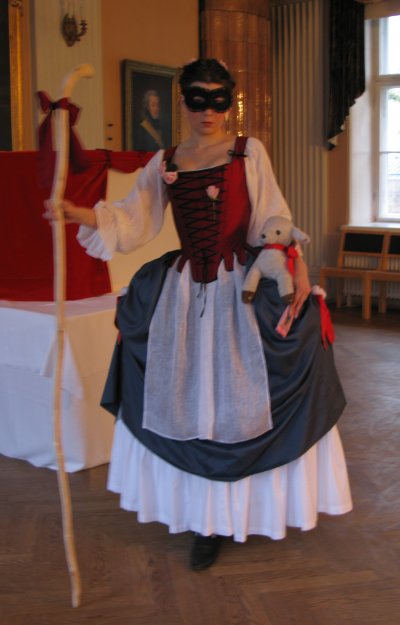
The ball was a large one with many great costumes, and we had so much fun. Our costumes were quite comfortable, so dancing didn't cause too much fatigue.
The stays, originally meant for a quick fancy dress project ended up much nicer than I had even expected. Apart from being very pretty they actually fit so well that I'm beginning to consider making brand new stays with this pattern and heavier boning for regular 18th century wear.
I think I'll also use these stays for a more relaxed 18th century wear on the future, and perhaps in real life too as they look so nice. Now that I've worn it three times the cable tie boning has slightly bended at the waist, but so far that doesn't really matter.
The third time I wore this was at my Halloween-party - my costume can be seen here.
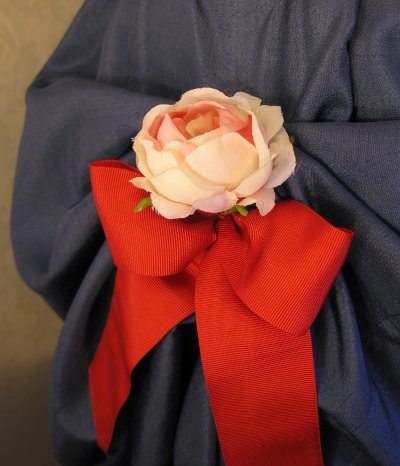
I would like to thank:
Fabian for help with the finishing
Kaisa for the lamb